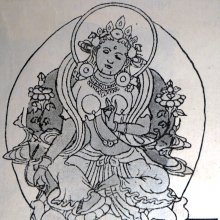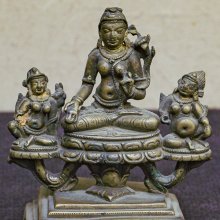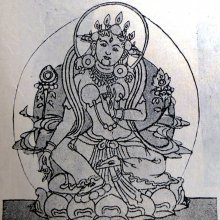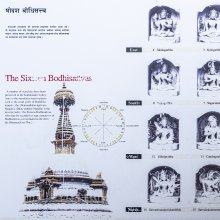Locana, Locanā: 33 definitions
Introduction:
Locana means something in Buddhism, Pali, Hinduism, Sanskrit, Jainism, Prakrit, the history of ancient India, Marathi, Hindi. If you want to know the exact meaning, history, etymology or English translation of this term then check out the descriptions on this page. Add your comment or reference to a book if you want to contribute to this summary article.
Alternative spellings of this word include Lochana.
Images (photo gallery)
In Hinduism
Natyashastra (theatrics and dramaturgy)
Source: archive.org: The Ragas Of Karnatic MusicLocana (लोचन).—Among northern authors, Locana in his Rāgataraṅgiṇī (18th century) mentions 12 rāga-saṃsthitis (another name for janaka-meḷas/ melās). He also speaks of rāgiṇīs.

Natyashastra (नाट्यशास्त्र, nāṭyaśāstra) refers to both the ancient Indian tradition (shastra) of performing arts, (natya—theatrics, drama, dance, music), as well as the name of a Sanskrit work dealing with these subjects. It also teaches the rules for composing Dramatic plays (nataka), construction and performance of Theater, and Poetic works (kavya).
Shaktism (Shakta philosophy)
Source: Kamakoti Mandali: The Yoginis of Narasimha VyuhaLocanā (लोचना) is the name of a Mātṛkā-Śakti created by Mahārudra in order to control the plague of demons created by Andhakāsura.—Accordingly, Andhaka-Asura tried to kidnap Umā (Devī Pārvatī), and was fiercely attacked by Mahārudra who shot arrows at him from his mahāpināka. when the arrows pierced the body of Andhakāsura, drops of blood fell to earth and from those drops, thousands of Andhakas arose. To control this plague of demons, Mahārudra created Mātṛkā-Śaktis [viz., Locanā] and ordered them to drink the blood of the demons and drain them dry.
Source: Kamakoti Mandali: Nrisimha matrika-mandalaLocanā (लोचना) refers to one of the various Mātṛkā-Śaktis created by Rudra in order to destroy the clones that spawned from Andhaka’s body.—Accordingly, [...] Andhakāsura attempted to abduct Girājanandinī (Pārvatī) and thus ensued a fierce battle between Andhakāsura and the great Rudra, the Lord of Umā. Like raktabīja, every drop of blood that fell from the body of Andhaka created another Asura like him and in no time, the entire world was filled with Andhakas. To destroy the growing number of Andhakas, Rudra created innumerable Mātṛkā-Śaktis [viz., Locanā]. These Śaktis of immense power at once began to drink every drop of blood that flowed from the body of Andhaka, but they could still not effectively contain the emergence of more and more demons.

Shakta (शाक्त, śākta) or Shaktism (śāktism) represents a tradition of Hinduism where the Goddess (Devi) is revered and worshipped. Shakta literature includes a range of scriptures, including various Agamas and Tantras, although its roots may be traced back to the Vedas.
Ayurveda (science of life)
Source: gurumukhi.ru: Ayurveda glossary of termsLocana (लोचन):—[locanaḥ] Eye

Āyurveda (आयुर्वेद, ayurveda) is a branch of Indian science dealing with medicine, herbalism, taxology, anatomy, surgery, alchemy and related topics. Traditional practice of Āyurveda in ancient India dates back to at least the first millenium BC. Literature is commonly written in Sanskrit using various poetic metres.
Shaivism (Shaiva philosophy)
Source: Brill: Śaivism and the Tantric TraditionsLocana (लोचन) refers to an “eye”, according to the Kiraṇatantra chapter 49 (dealing with vratacaryā).—Accordingly, “Garuḍa spoke: ‘You have taught me, O great Lord, the activities of the Neophyte, the Putraka and the Ācārya. Tell me those of the Sādhaka’. The Lord spoke: ‘[...] This is the auspicious Raudra-vrata: imposing with a chignon of matted locks, marked by a trident and khaṭvāṅga, equipped with a clean half skull, awe-inspiring with a third eye (tṛ-locana-kṛtādara), clothed in the skin of a tiger, peaceful. For one firm [in this observance], the highest siddhi will arise in six months; middling [powers] in four months; the lowest [powers] will arise in three months. [...]’”.

Shaiva (शैव, śaiva) or Shaivism (śaivism) represents a tradition of Hinduism worshiping Shiva as the supreme being. Closely related to Shaktism, Shaiva literature includes a range of scriptures, including Tantras, while the root of this tradition may be traced back to the ancient Vedas.
Ganitashastra (Mathematics and Algebra)
Source: archive.org: Hindu MathematicsLocana (लोचन) represents the number 2 (two) in the “word-numeral system” (bhūtasaṃkhyā), which was used in Sanskrit texts dealing with astronomy, mathematics, metrics, as well as in the dates of inscriptions and manuscripts in ancient Indian literature.—A system of expressing numbers by means of words arranged as in the place-value notation was developed and perfected in India in the early centuries of the Christian era. In this system the numerals [e.g., 2—locana] are expressed by names of things, beings or concepts, which, naturally or in accordance with the teaching of the Śāstras, connote numbers.

Ganitashastra (शिल्पशास्त्र, gaṇitaśāstra) refers to the ancient Indian science of mathematics, algebra, number theory, arithmetic, etc. Closely allied with astronomy, both were commonly taught and studied in universities, even since the 1st millennium BCE. Ganita-shastra also includes ritualistic math-books such as the Shulba-sutras.
Purana and Itihasa (epic history)
Source: archive.org: Shiva Purana - English TranslationLocana (लोचन) refers to the “(third) eye (of Śiva)”, according to the Śivapurāṇa 2.3.39 (“The gods arrive at Kailāsa”).—Accordingly, as the guests arrived for Śiva’s marriage: “[...] The seven Mothers performed the rites of bedecking Śiva in a fitting manner very joyously. Even the very natural dress and features of Śiva assumed the work of ornamentation, O excellent sage, at the will of lord Siva. The moon took the place of the crown. The third eye (locana) became the beautiful ornament on the forehead. [...]”.

The Purana (पुराण, purāṇas) refers to Sanskrit literature preserving ancient India’s vast cultural history, including historical legends, religious ceremonies, various arts and sciences. The eighteen mahapuranas total over 400,000 shlokas (metrical couplets) and date to at least several centuries BCE.
In Buddhism
Tibetan Buddhism (Vajrayana or tantric Buddhism)
Source: Wisdom Library: Tibetan BuddhismLocanā (लोचना) is the name of Vidyārājñī (i.e., “wisdom queen”) mentioned as attending the teachings in the 6th century Mañjuśrīmūlakalpa: one of the largest Kriyā Tantras devoted to Mañjuśrī (the Bodhisattva of wisdom) representing an encyclopedia of knowledge primarily concerned with ritualistic elements in Buddhism. The teachings in this text originate from Mañjuśrī and were taught to and by Buddha Śākyamuni in the presence of a large audience (including Locanā).
Source: archive.org: The Indian Buddhist IconographyLocanā (लोचना) is the Śakti, or female counterpart (spiritual consort) of Vairocana: one of the Dhyāni-Buddhas, according to Vajrayāna or Tantric Buddhism.—Her colour is white; she has two arms; and her symbol is the discuss.—The Dhyāni Buddhas are all associated with their Śakti or female counterpart and an offspring or Bodhisattva. They fall into a separate group of five or six if Vajrasattva is added. Locanā belongs to the Tathāgata family to which the Dhyāni Buddha Vairocana also belongs. Thus Locanā is the, Śakti or the female counterpart of the Dhyāni Buddha Vairocana.
A short Dhyāna in the Advayavajrasaṃgraha describes Locanā’s form thus:—“On the disc of the moon on the petal in the Agni corner there is Locanā originating from the white germ syllable Loṃ. She is white in colour, bears the recognition symbol of the discus, and is the embodient of the cosimc element of Earth. She belongs to the Tathāgata family an is steeped in delusion”.
Source: Wisdomlib Libary: Vajrayogini1) Locanā (लोचना) is the presiding deity of the northern lotus of the vārāhyabhyudaya-maṇḍala, according to the Vārāhyabhyudayatantra (largerly extracted from the 10th century Abhidhānottaratantra). She is the presiding lady (kuleśvarī) of the karma (Amoghasiddhi) family. The central deity of the vārāhyabhyudaya-maṇḍala is the twelve-armed Vajravarāhī, which is modeled upon the twelve-armed Cakrasaṃvara, thus inhibiting many similar iconographical features.
Locanā has three faces of three colors (green, white and red) and is to be visualised as naked and wearing only a agarland of heads, dancing upon the four māras. She has six arms and her attributes include the cihnam (family emblem), the vajra, the double vajra, a red lotus and a wheel.
The lotus upon which Locanā presides has 6 petals and corresponding goddesses residing in pīṭhas (sacred site):
- Laṅkeśvarī in Devīkoṭa,
- Drumacchāyā in Mālava,
- Airāvatī in Kāmarūpa,
- Mahābhairavā in Oḍra,
- Vāyuvegā in Triśakuni,
- Surābhakṣī in Kośala.
2) Locanā (लोचना) is an alternative name of Pātanī: a deity to be contemplated upon by a practicioner purifying his correspondences (viśuddhi), according to the 12th-century Abhisamayamañjarī. Pātanī is alternatively known by the name Locanā one of the traditional consorts of the Buddha and a mother of the yogatantra system. The contemplation is prescribed as a preliminary ritual for a yogin wishing to establish, or reestablish the union with a deity.
Locanā is associated with the element space and the color yellow. She is to be visualised as assuming a kāpālika form, naked with loose hair and holding tantric attributes in their four arms.
Source: academia.edu: The Structure and Meanings of the Heruka MaṇḍalaLocanā (लोचना) is the name of a Ḍākinī who, together with the Vīra (hero) named Locana forms one of the 36 pairs situated in the Hṛdayacakra, according to the 10th century Ḍākārṇava chapter 15. Accordingly, the hṛdayacakra refers to one of the four divisions of the sahaja-puṭa (‘innate layer’), situated within the padma (lotus) in the middle of the Herukamaṇḍala. The 36 pairs of Ḍākinīs [viz., Locanā] and Vīras are reddish yellow in color; they each have one face and four arms; they hold a skull bowl, a skull staff, a small drum, and a knife.
Source: OSU Press: Cakrasamvara SamadhiLocanā (लोचना) is the name of a deity [i.e., oṃ locanāyai svāhā], according to the Guru Mandala Worship (maṇḍalārcana) ritual often performed in combination with the Cakrasaṃvara Samādhi, which refers to the primary pūjā and sādhanā practice of Newah Mahāyāna-Vajrayāna Buddhists in Nepal.—

Tibetan Buddhism includes schools such as Nyingma, Kadampa, Kagyu and Gelug. Their primary canon of literature is divided in two broad categories: The Kangyur, which consists of Buddha’s words, and the Tengyur, which includes commentaries from various sources. Esotericism and tantra techniques (vajrayāna) are collected indepently.
Mahayana (major branch of Buddhism)
Source: academia.edu: A Study and Translation of the GaganagañjaparipṛcchāLocanā (लोचना) refers to the “eye (of the Buddha)”, according to the Gaganagañjaparipṛcchā: the eighth chapter of the Mahāsaṃnipāta (a collection of Mahāyāna Buddhist Sūtras).—Accordingly, “Then the Lord spoke the following verses to the Bodhisattva Puṇyālaṃkāra: ‘(233) Even though the Bodhisattva sees immeasurably extensive fields in ten directions by the eye of the Buddha (buddha-locanā), fills all those places with jewels, and gives them as a gift, if there is someone who retains, reads and teaches such excellent and unsullied sūtra which has been taught by many Buddhas, then his merit would be better. [...]’”

Mahayana (महायान, mahāyāna) is a major branch of Buddhism focusing on the path of a Bodhisattva (spiritual aspirants/ enlightened beings). Extant literature is vast and primarely composed in the Sanskrit language. There are many sūtras of which some of the earliest are the various Prajñāpāramitā sūtras.
In Jainism
General definition (in Jainism)
Source: The University of Sydney: A study of the Twelve ReflectionsLocana (लोचन) refers to “sight”, according to the 11th century Jñānārṇava, a treatise on Jain Yoga in roughly 2200 Sanskrit verses composed by Śubhacandra.—Accordingly, “This living soul, whose own nature is unknown, whose sight is deprived of perception, etc. (locana—luptabodhādilocanaḥ) [and] who is tricked by [his] actions, continually roams about alone. When this [living soul] thinks, because of delusion, about unity with objects of the senses which are immovable and other than immovable then he binds himself with his own [action]. Contrary to that, he may obtain liberation”.

Jainism is an Indian religion of Dharma whose doctrine revolves around harmlessness (ahimsa) towards every living being. The two major branches (Digambara and Svetambara) of Jainism stimulate self-control (or, shramana, ‘self-reliance’) and spiritual development through a path of peace for the soul to progess to the ultimate goal.
India history and geography
Source: Cologne Digital Sanskrit Dictionaries: Indian Epigraphical GlossaryLocana.—(IE 7-1-2), ‘two’. Note: locana is defined in the “Indian epigraphical glossary” as it can be found on ancient inscriptions commonly written in Sanskrit, Prakrit or Dravidian languages.
Source: OpenEdition books: Vividhatīrthakalpaḥ (History)Locanā (लोचना) is the name of a Tīrtha (i.e., non-Jaina holy places), associated with Vaibhāra, as is mentioned in the Vividhatīrthakalpa by Jinaprabhasūri (13th century A.D.): an ancient text devoted to various Jaina holy places (tīrthas).

The history of India traces the identification of countries, villages, towns and other regions of India, as well as mythology, zoology, royal dynasties, rulers, tribes, local festivities and traditions and regional languages. Ancient India enjoyed religious freedom and encourages the path of Dharma, a concept common to Buddhism, Hinduism, and Jainism.
Languages of India and abroad
Pali-English dictionary
Source: BuddhaSasana: Concise Pali-English Dictionarylocana : (nt.) the eye.
Source: Sutta: The Pali Text Society's Pali-English Dictionary1) Locana, 2 (nt.) (fr. Loc. Caus. of luñcati) pulling, tearing out D. I, 167 (kesa-massu°); A. I, 296; Pug. 55. (Page 588)
2) Locana, 1 (fr. loc or lok to see; Dhtp 532 & Dhtm 766: loc= dassana) the eye; adj. (-°) having eyes. (of ... ) Pv. I, 115 (miga-manda°); PvA. 57, 90 (pingala°). (Page 588)

Pali is the language of the Tipiṭaka, which is the sacred canon of Theravāda Buddhism and contains much of the Buddha’s speech. Closeley related to Sanskrit, both languages are used interchangeably between religions.
Marathi-English dictionary
Source: DDSA: The Molesworth Marathi and English Dictionarylōcana (लोचन).—n (S) An eye.
Source: DDSA: The Aryabhusan school dictionary, Marathi-Englishlōcana (लोचन).—n An eye.
Marathi is an Indo-European language having over 70 million native speakers people in (predominantly) Maharashtra India. Marathi, like many other Indo-Aryan languages, evolved from early forms of Prakrit, which itself is a subset of Sanskrit, one of the most ancient languages of the world.
Sanskrit dictionary
Source: DDSA: The practical Sanskrit-English dictionaryLocana (लोचन).—a. (-nī f.)
1) Illuminating, brightening.
2) Visible.
-nam [locyate'nena loc-karaṇe lyuṭ]
1) Seeing, sight, viewing.
2) The eye; शेषान् मासान् गमय चतुरो लोचने मीलयित्वा (śeṣān māsān gamaya caturo locane mīlayitvā) Meghadūta 112.
Source: Cologne Digital Sanskrit Dictionaries: Edgerton Buddhist Hybrid Sanskrit DictionaryLocanā (लोचना).—name of a goddess (= Buddhalocanā, Rocanī): Sādhanamālā 18.13 etc.
Source: Cologne Digital Sanskrit Dictionaries: Shabda-Sagara Sanskrit-English DictionaryLocana (लोचन).—n.
(-naṃ) 1. The eye. 2. Seeing, looking. f.
(-nā) A goddess of the Jainas. E. loc to see, lyuṭ or yuc aff.
Source: Cologne Digital Sanskrit Dictionaries: Benfey Sanskrit-English DictionaryLocana (लोचन).—[loc + ana], n. The eye, [Vikramorvaśī, (ed. Bollensen.)] [distich] 56.
Source: Cologne Digital Sanskrit Dictionaries: Cappeller Sanskrit-English DictionaryLocana (लोचन).—[adjective] enlightening, [neuter] eye.
Source: Cologne Digital Sanskrit Dictionaries: Aufrecht Catalogus CatalogorumLocana (लोचन) as mentioned in Aufrecht’s Catalogus Catalogorum:—and locanakāra alaṃk. See Dhvanyālokalocana.
Source: Cologne Digital Sanskrit Dictionaries: Monier-Williams Sanskrit-English Dictionary1) Locana (लोचन):—[from loc] mfn. illuminating, brightening, [Bhāgavata-purāṇa]
2) [v.s. ...] m. Name of an author, [Catalogue(s)]
3) [v.s. ...] f(ā or ī). Name of a Buddhist goddess, [Dharmasaṃgraha 4]
4) [from loc] n. (ifc. f(ā). ) ‘organ of sight’, the eye, [Mahābhārata; Kāvya literature etc.]
5) [v.s. ...] Name of [work]
Source: Cologne Digital Sanskrit Dictionaries: Yates Sanskrit-English DictionaryLocana (लोचन):—(naṃ) 1. n. f. The eye.
Source: DDSA: Paia-sadda-mahannavo; a comprehensive Prakrit Hindi dictionary (S)Locana (लोचन) in the Sanskrit language is related to the Prakrit word: Loaṇa.
[Sanskrit to German]
Sanskrit, also spelled संस्कृतम् (saṃskṛtam), is an ancient language of India commonly seen as the grandmother of the Indo-European language family (even English!). Closely allied with Prakrit and Pali, Sanskrit is more exhaustive in both grammar and terms and has the most extensive collection of literature in the world, greatly surpassing its sister-languages Greek and Latin.
Hindi dictionary
Source: DDSA: A practical Hindi-English dictionaryLocana (लोचन) [Also spelled lochan]:—(nm) eye (s).
...
Kannada-English dictionary
Source: Alar: Kannada-English corpusLōcana (ಲೋಚನ):—
1) [adjective] twinkling or shining brightly; lustrous.
2) [adjective] being seen; visible.
--- OR ---
Lōcana (ಲೋಚನ):—
1) [noun] the organ of sight; the eye.
2) [noun] that which is seen; a sight.
3) [noun] (math.) a symbol for the number two.
Kannada is a Dravidian language (as opposed to the Indo-European language family) mainly spoken in the southwestern region of India.
See also (Relevant definitions)
Starts with (+1): Locanagocara, Locanahita, Locanajala, Locanaka, Locanakara, Locanamarga, Locanamaya, Locanananda, Locanancala, Locananjana, Locanaparusha, Locanapata, Locanapatha, Locanashruti, Locanashrutipa, Locanastra, Locanatrayapatha, Locanavarana, Locanavartta, Locanavat.
Ends with (+152): Abhilocana, Abhinimlocana, Abjalocana, Agnilocana, Ahilocana, Alikalocana, Alocana, Ambhojalocana, Amitalocana, Amritalocana, Anekalocana, Animeshalocana, Animishalocana, Antargatalocana, Arunalocana, Asamalocana, Ashrulocana, Ashruvilocana, Astravidyabhalalocana, Atmalocana.
Full-text (+248): Carulocana, Vamalocana, Paryalocana, Vrishalocana, Harilocana, Citralocana, Taralalocana, Mrigilocana, Kamalalocana, Arunalocana, Diptalocana, Raktalocana, Trilocana, Mrigalocana, Kruralocana, Locanagocara, Locanamaya, Vilocana, Karalalocana, Dhumralocana.
Relevant text
Search found 46 books and stories containing Locana, Locanā, Lōcana; (plurals include: Locanas, Locanās, Lōcanas). You can also click to the full overview containing English textual excerpts. Below are direct links for the most relevant articles:
Sahitya-kaumudi by Baladeva Vidyabhushana (by Gaurapada Dāsa)
Text 11.18 < [Chapter 11 - Additional Ornaments]
Text 8.8 < [Chapter 8 - Literary Qualities]
Text 10.68 < [Chapter 10 - Ornaments of Meaning]
Garga Samhita (English) (by Danavir Goswami)
Verse 2.17.30 < [Chapter 17 - The Meeting of Śrī Rādhā-Kṛṣṇa]
Verse 5.4.6 < [Chapter 4 - The Journey to Śrī Mathurā]
Verse 5.18.21 < [Chapter 18 - Uddhava Hears the Gopīs’ Words and Returns to Mathurā]
Bhajana-Rahasya (by Srila Bhaktivinoda Thakura Mahasaya)
Text 34 < [Chapter 1 - Prathama-yāma-sādhana (Niśānta-bhajana–śraddhā)]
Text 24 < [Chapter 8 - Aṣṭama-yāma-sādhana (Rātri-līlā–prema-bhajana sambhoga)]
Bhakti-rasamrta-sindhu (by Śrīla Rūpa Gosvāmī)
Verse 2.1.231 < [Part 1 - Ecstatic Excitants (vibhāva)]
Verse 4.1.24 < [Part 1 - Laughing Ecstasy (hāsya-rasa)]
Verse 4.1.22 < [Part 1 - Laughing Ecstasy (hāsya-rasa)]
The Indian Buddhist Iconography (by Benoytosh Bhattachacharyya)
Related products





